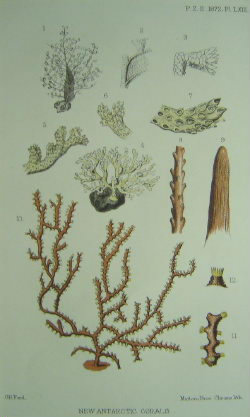
"And immediately there is the problem of the climate. There were ancient climates that were very different from what they are today. If those corals grew where they were found, certainly the Earth was not travelling with the same elements of rotation and revolution which means not in the same orbit, not with the axis directed in the same position as it is today. If you don't believe it, try to cultivate corals on the North Pole." -- Immanuel Velikovsky, cosmologist, 1966
Via The New York Times 1984:
FOR years a few imaginative authors have argued, based on 16th century maps, that the ice-covered continent of Antarctica was discovered and mapped by an ancient civilization, perhaps one from another planet. The latter proposition was dismissed by most geographers and historians as preposterous.Sullivan, W., New Analysis Hints Ancient Explorers Mapped Antarctic, The New York Times, Sep 1984
Nevertheless, a careful comparison of information appearing on the maps with what is now known of the continent has led a leading geologist and polar specialist to propose that the outlines of Antarctica may, in fact, have been known long before Columbus reached America.
Via Science News 1986:
The new find of roots and stems of wooden plants and of pollen in an area stretching about 1,300 kilometers along the Transantarctic Mountains means not only that the ice retreated but also that the climate was warm enough to support a shrublike beach forest. "The presence of the wood means that there was deglaciation on a major scale, with conditions radically different than they are today," says David Elliot, chief scientist of the recent National Science Foundation polar expedition, of which Webb's group was part. "This is a very significant find." Webb thinks the forest region a few million years ago must have resembled the present-day fjords of Chile and Norway.Weisburd, S., A Forest Grows In Antarctica, Science News, Volume 129, Number 148, Mar 1986
According to Webb, before the forest developed, the region was covered by a considerable amount of ice. So an important question is where the forest and pollen came from. "Had the forest been living there all the time, and are we overestimating the severity of the earlier glacial record?" he wonders.
Via Terra Antarctica Reports 1999:
The [Antarctic] ice sheet has resulted in one of the most extreme environments on the planet - mean annual temperature in the interior is between -50oC and -60oC - and yet in the distant past 200 million years ago the Antarctic was a continent of forests and plains with temperatures of around 10oC or more. Here we review evidence from the Antarctic continent of changes in climate that have taken place over the last 100 million years, a period that has seen the formation of a mountain range across the middle of the continent, and its change from an ice-free to an ice-covered state.Barrett, P., Antarctic Climate History Over The Last 100 Million Years, Terra Antarctica Reports, Volume 3, Pages 53-72, 1999
Via Science Daily 2008:
ScienceDaily (July 29, 2008) — A snapshot of New Zealand’s climate 40 million years ago reveals a greenhouse Earth, with warmer seas and little or no ice in Antarctica, according to research recently published in the journal Geology.Snapshot of Past Climate Reveals No Ice In Antarctica Millions of Years Ago, Science Daily, Jul 2008
The study suggests that Antarctica at that time was yet to develop extensive ice sheets. ...
“This is too warm to be the Antarctic water we know today,” said Dr Catherine (Cat) Burgess from Cardiff University and lead-author of the paper. “And the seawater chemistry shows there was little or no ice on the planet.”
Great post!
ReplyDelete